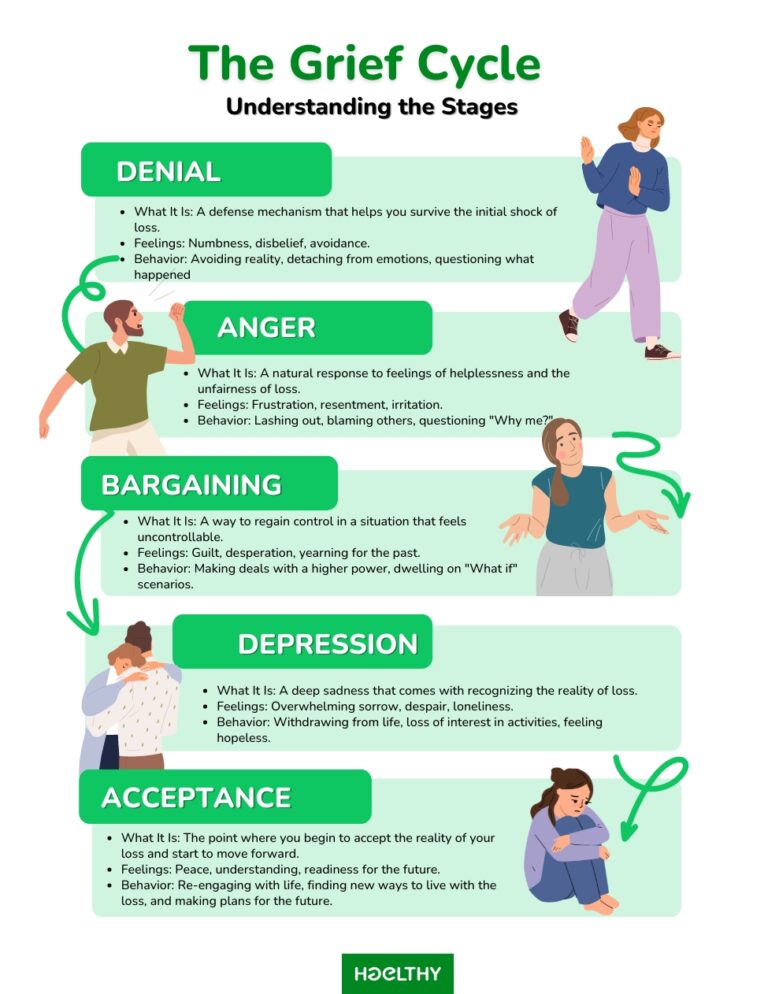Grief is a universal human experience, touching everyone in some way at different points in life. When we lose someone or something deeply important to us, the emotional response can be overwhelming. Understanding the grief cycle can help us make sense of the intense feelings we experience during this difficult time. Dr. Elisabeth Kübler-Ross famously described the five stages of grief in her groundbreaking work, which outlines a natural progression that many people go through. These stages are denial, anger, bargaining, depression, and acceptance. While not everyone experiences all stages or in a linear order, each stage helps us cope with loss and eventually find peace.
The Grief Cycle
1. Denial: Facing the Initial Shock
The first stage of grief is denial. When confronted with a devastating loss, our minds naturally attempt to protect us from the full impact by entering a state of disbelief. Denial is a defense mechanism that allows us to survive the initial emotional blow. During this stage, we may feel numb or detached from reality. It can be difficult to comprehend that the loss has occurred, and we may even avoid talking or thinking about it altogether.
For example, a person who has lost a loved one might repeatedly tell themselves that it’s not real or that the person will return soon. This temporary buffer against the overwhelming reality helps individuals process the situation at a slower pace, making it more bearable in the short term. However, as denial fades, the pain of the loss begins to surface, often leading to the next stage—anger.
2. Anger: The Outpouring of Emotion
As the initial shock wears off, the emotions we tried to suppress during denial come rushing to the surface, and anger is often the result. Anger can feel all-consuming, and it’s not always directed at a single target. People grieving might become angry at themselves, at others, or even at the person they’ve lost. There may be feelings of frustration, resentment, or a deep sense of unfairness.
In this stage, it’s not uncommon for people to question, “Why me?” or “Why them?” They may lash out at loved ones or medical professionals or blame themselves for not doing more to prevent the loss. Although anger may seem negative, it’s a necessary step in the healing process, as it allows the griever to begin confronting the emotions they’ve been holding inside. Rather than suppressing or judging the anger, acknowledging it as part of grief’s complexity can help us move through it.
3. Bargaining: Attempting to Regain Control
When faced with a loss that feels beyond our control, the natural instinct is to try to regain some sense of power over the situation. This is where the stage of bargaining comes in. Bargaining involves thoughts of “What if” and “If only,” as we mentally retrace steps and imagine different outcomes. In this stage, people may attempt to negotiate with a higher power, hoping for a reversal of the situation. For example, someone might pray, “If only you bring them back, I will change my life.”
Feelings of guilt and regret are common here, as people dwell on how things might have been different if they had made different choices or taken specific actions. This stage is often a way to postpone the sadness that follows the reality of the loss. Bargaining gives the griever a temporary sense of control, even though deep down, they may recognize that the loss is irreversible.
4. Depression: The Weight of Reality
Once the bargaining phase ends and the individual realizes that no amount of negotiating can change the outcome, deep sadness sets in. This stage, known as depression, involves confronting the full weight of the loss. It’s characterized by overwhelming sorrow, loneliness, and a sense of despair.
Unlike clinical depression, the depressive feelings in this stage are a natural and expected part of grief. It’s a time when individuals withdraw from daily life, lose interest in activities, and feel a profound sense of hopelessness. This phase can feel like the darkest part of the grief cycle, but it’s also a time for reflection. Allowing oneself to feel the full weight of the loss is an essential part of moving forward, even though it can be incredibly painful.
5. Acceptance: Moving Forward with Peace
Acceptance is the final stage of the grief cycle, where individuals begin to come to terms with their loss. It’s important to note that acceptance does not mean that the person is “over” their grief. Instead, acceptance involves reaching a point where they are no longer resisting the reality of the situation and are able to live with it. There’s a renewed sense of peace and understanding.
In this stage, the griever starts to re-engage with life and plan for the future, although the loss remains a significant part of their emotional landscape. They may find new ways to incorporate the memory of their loved one into their life or come to terms with a major life change in a healthy and constructive way.
Navigating Grief: A Personal Journey
The grief cycle is not a one-size-fits-all process. Some people may not experience every stage, while others may move back and forth between stages before reaching acceptance. The journey through grief is as unique as the individual experiencing it. Grieving is a natural process, and it’s important to allow yourself the time and space to heal. Whether you’re dealing with loss yourself or supporting someone else through their grief, understanding these stages can provide valuable insight into the complex emotional landscape of healing.
If you or someone you know is struggling with grief, consider seeking professional support from a counselor or grief therapist. Talking about your emotions and understanding where you are in the grief cycle can be a powerful step toward healing and finding peace after loss.





